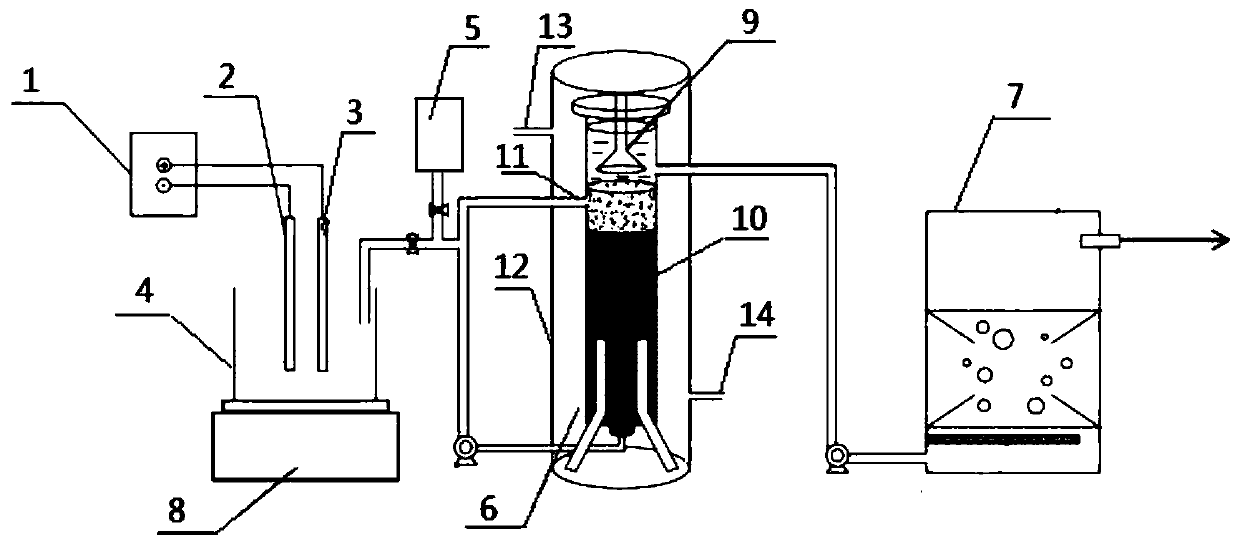Device and method for treating wastewater containing fluoroquinolone antibiotics
A technology of quinolones and antibiotics, applied in the field of waste water devices, can solve problems such as poor removal effect, low light utilization rate, and complicated treatment process, so as to improve biodegradability, reduce inhibition, and increase economic benefits Effect
- Summary
- Abstract
- Description
- Claims
- Application Information
AI Technical Summary
Problems solved by technology
Method used
Image
Examples
Embodiment 1
[0033] Such as figure 1 As shown, a device for treating wastewater containing fluoroquinolone antibiotics, including DC stabilized power supply 1, cathode 2, anode 3, electrolytic cell 4, domestic sewage collection tank 5, upflow sulfate reduction anaerobic sludge bed reaction device 6 and biological contact oxidation tank 7, the anode 3 is connected to the positive pole of the DC stabilized power supply 1, the cathode 2 is connected to the negative pole of the DC stabilized power supply 1, and the lower ends of the anode and the cathode are immersed in the waste water to be treated in the electrolytic cell 4, The bottom of the electrolytic cell 4 is provided with a magnetic stirrer 8; the electrolytic cell 4 communicates with the bottom water inlet of the upflow sulfate reduction anaerobic sludge bed reactor 6 through pipelines and peristaltic pumps, and the upflow sulfate reduction The upper part of the anaerobic sludge bed reactor 6 is provided with an internal circulation ...
Embodiment 2
[0036] The water quality of the wastewater containing fluoroquinolone antibiotics to be treated: antibiotic 5mg / L, sulfate 0.04mol / L, TOC 3000mg / L.
[0037] Utilize the device of embodiment 1 to process the method for the waste water containing above-mentioned fluoroquinolone antibiotics, comprise the steps:
[0038] (1) Pour the waste water containing fluoroquinolone antibiotics into the electrolytic cell, turn on the magnetic stirrer, start the DC stabilized voltage power supply simultaneously, and be electrolyzed for 4h under the condition of pH 7.6-7.8 (the electrolytic current density is 300A / m 2 , the rotating speed of the magnetic stirrer is 500 ± 50r / min), and the wastewater after electrolytic treatment is obtained;
[0039] (2) Open the valve, pump the electrolytically treated wastewater and domestic sewage (TOC 900mg / L) into the upflow sulfate reduction anaerobic sludge bed reactor for anaerobic reaction, and feed hot water from the hot water inlet Maintain the reac...
Embodiment 3
[0043] The water quality of the wastewater containing fluoroquinolone antibiotics to be treated: antibiotics 100mg / L, sodium sulfate 0.04mol / L, TOC 120mg / L.
[0044] Utilize the device of embodiment 1 to process the wastewater containing fluoroquinolone antibiotics, the method may further comprise the steps:
[0045] (1) Pour the waste water containing fluoroquinolone antibiotics into the electrolytic cell, turn on the magnetic stirrer, start the DC stabilized voltage power supply simultaneously, and be electrolyzed for 4h under the condition of pH 7.6-7.8 (the electrolytic current density is 300A / m 2 , the rotating speed of the magnetic stirrer is 500 ± 50r / min), and the wastewater after electrolytic treatment is obtained;
[0046] (2) Open the valve, pump the electrolytically treated wastewater and domestic sewage (TOC 950mg / L) into the upflow sulfate reduction anaerobic sludge bed reactor for anaerobic reaction, and feed hot water from the hot water inlet Maintain the reac...
PUM
 Login to View More
Login to View More Abstract
Description
Claims
Application Information
 Login to View More
Login to View More - R&D
- Intellectual Property
- Life Sciences
- Materials
- Tech Scout
- Unparalleled Data Quality
- Higher Quality Content
- 60% Fewer Hallucinations
Browse by: Latest US Patents, China's latest patents, Technical Efficacy Thesaurus, Application Domain, Technology Topic, Popular Technical Reports.
© 2025 PatSnap. All rights reserved.Legal|Privacy policy|Modern Slavery Act Transparency Statement|Sitemap|About US| Contact US: help@patsnap.com

